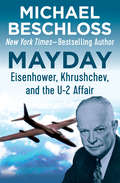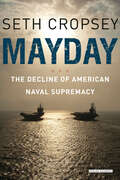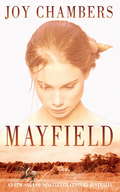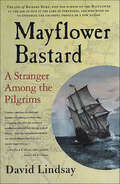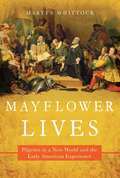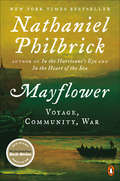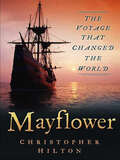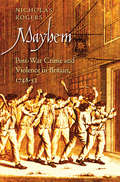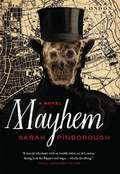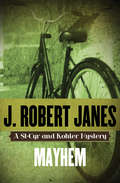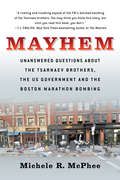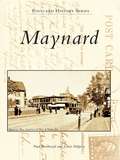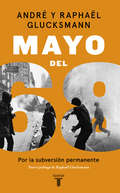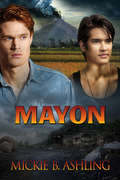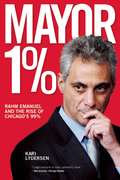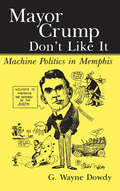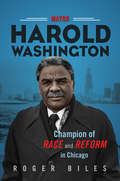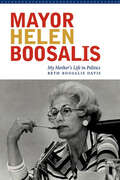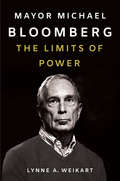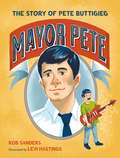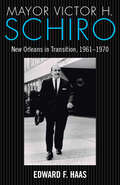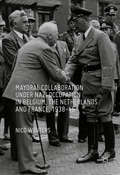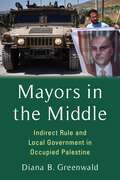- Table View
- List View
Mayday: Eisenhower, Khrushchev and the U-2 Affair
by Michael BeschlossOn May 1, 1960, Francis Gary Powers flew a U-2 spy plane deep into Soviet airspace and was downed. Powers and his equipment survived and were captured, becoming a pivotal episode in the Cold War.
Mayday: Eisenhower, Khrushchev, and the U-2 Affair
by Michael BeschlossThe &“definitive&” book on the U-2 episode and its disastrous impact on the future of the Cold War (Kirkus Reviews). On May Day 1960, Soviet forces downed a CIA spy plane flown deep into Soviet territory by Francis Gary Powers two weeks before a crucial summit. This forced President Dwight Eisenhower to decide whether, in an effort to save the meeting, to admit to Soviet Premier Nikita Khrushchev—and the world—that he had secretly ordered Powers&’s flight, or to claim that the CIA could take such a significant step without his approval. In rich and fascinating detail, Mayday explores the years of U-2 flights, which Eisenhower deemed &“an act of war,&” the US government&’s misconceived attempt to cover up the true purpose of the flight, Khrushchev&’s dramatic revelation that Powers was alive and in Soviet custody, and the show trial that sentenced the pilot to prison and hard labor. From a U-2&’s cramped cockpit to tense meetings in the Oval Office, the Kremlin, Camp David, CIA headquarters, the Élysée Palace, and Number Ten Downing Street, historian Michael Beschloss draws on previously unavailable CIA documents, diaries, and letters, as well as the recollections of Eisenhower&’s aides, to reveal the full high-stakes drama and bring to life its key figures, which also include Richard Nixon, Allen Dulles, and Charles de Gaulle. An impressive work of scholarship with the dramatic pacing a spy thriller, Mayday &“may be one of the best stories yet written about just how those grand men of diplomacy and intrigue conducted our business&” (Time).
Mayday: The Decline of American Naval Supremacy
by Seth CropseyA naval expert charts the rise and fall of America’s maritime supremacy—and what it means for the future of U.S. security and prosperity.As with other powerful nations throughout history, maritime supremacy has been the key to America’s superpower status and the relative peace of the postwar era. But in the twenty-first century, the United States Navy’s combat fleet has dwindled to historic lows—the smallest since before World War I. At the same time, rival nations such as China have increased the size of their navies at an extraordinary rate. As Seth Cropsey convincingly argues, the precipitous decline of the U.S. as a great seapower will have profound consequences sooner than we might think. In clear and concise language, Mayday tracks the modern evolution of U.S. maritime strength, where it stands now, and the likely consequences if changes are not made to both the Navy’s size and shape and to the United States’ strategic understanding of how to combine maritime and continental force.
Mayfield: An epic saga of love, loss and sacrifice
by Joy ChambersThe overwhelming and consuming love of two men for the same indomitable woman...Mayfield is Joy Chambers' gripping saga set across nineteenth-century Australia and all the way to Boston, USA. The perfect read for fans of Judith Kinghorn and Patricia Shaw.'Written with an ease of style and sophistication' - Liverpool Echo In the grandest wedding the small western plains town of Bathurst has ever seen, Eve Herman, without position or money, is marrying John Stuart Wakeman, one of the richest, most influential men in the land. Before their wedding day is over, Australia's most wanted man, the bushranger Alan Fletcher, will have held up their coach and altered all their lives... Alan Fletcher: aristocrat and Royal Naval Captain, wrongly convicted of murder and transported to New South Wales for life. Eve Herman: American orphan, abandoned in Sydney town and left to survive by her wits and courage. John Stuart Wakeman: the owner of fabled Mayfield, Australia's largest and most prosperous cattle property. Mayfield is their story: from the streets of Southampton to the vast bush country of New South Wales and across the world to the city of old Boston, USA.What people are saying about Mayfield:'Very enlightening historical facts add to the depth of the story. Highly recommended' 'Totally absorbing''If you love family sagas then this book is for you'
Mayfield: An epic saga of love, loss and sacrifice
by Joy ChambersThe overwhelming and consuming love of two men for the same indomitable woman...Mayfield is Joy Chambers' gripping saga set across nineteenth-century Australia and all the way to Boston, USA. The perfect read for fans of Judith Kinghorn and Patricia Shaw.'Written with an ease of style and sophistication' - Liverpool Echo In the grandest wedding the small western plains town of Bathurst has ever seen, Eve Herman, without position or money, is marrying John Stuart Wakeman, one of the richest, most influential men in the land. Before their wedding day is over, Australia's most wanted man, the bushranger Alan Fletcher, will have held up their coach and altered all their lives... Alan Fletcher: aristocrat and Royal Naval Captain, wrongly convicted of murder and transported to New South Wales for life. Eve Herman: American orphan, abandoned in Sydney town and left to survive by her wits and courage. John Stuart Wakeman: the owner of fabled Mayfield, Australia's largest and most prosperous cattle property. Mayfield is their story: from the streets of Southampton to the vast bush country of New South Wales and across the world to the city of old Boston, USA.What people are saying about Mayfield:'Very enlightening historical facts add to the depth of the story. Highly recommended' 'Totally absorbing''If you love family sagas then this book is for you'
Mayflower Bastard: A Stranger Among the Pilgrims
by David LindsayDavid Lindsay, researching old records to learn details of the life of his ancestor, Richard More, soon found himself in the position of the Sorcerer's Apprentice-wherever he looked for one item, ten more appeared. What he found illuminated not only More's own life but painted a clear and satisfying picture of the way the First Comers, Saints and Strangers alike, set off for the new land, suffered the voyage on the Mayflower, and put down their roots to thrive on our continent's northeastern shore. From the story, Richard emerges as a man of questionable morals, much enterprise, and a good deal of old-fashioned pluck, a combination that could get him into trouble-and often did. He lived to father several children, to see, near the end of his life, a friend executed as a witch in Salem, and to be read out of the church for unseemly behavior. Mayflower Bastard lets readers see history in a new light by turning an important episode into a personal experience.
Mayflower Lives: Pilgrims In A New World And The Early American Experience
by Martyn WhittockA fresh and revealing history of one of the most seminal events in American history as seen through fourteen diverse and dynamic figures. Leading into the 400th anniversary of the voyage of the Mayflower, Martyn Whittock examines the lives of the “saints” (members of the Separatist puritan congregations) and “strangers” (economic migrants) on the original ship. Collectively, these people would become known to history as “the Pilgrims.” The story of the Pilgrims has taken on a life of its own as one of our founding national myths—their escape from religious persecution, the dangerous transatlantic journey, that brutal first winter. Throughout the narrative, we meet characters already familiar to us through Thanksgiving folklore—Captain Jones, Myles Standish, and Tisquantum (Squanto)—as well as new ones. There is Mary Chilton, the first woman to set foot on shore, and asylum seeker William Bradford. We meet fur trapper John Howland and little Mary More, who was brought as an indentured servant. Then there is Stephen Hopkins, who had already survived one shipwreck and was the only Mayflower passenger with any prior American experience. Decidedly un-puritanical, he kept a tavern and was frequently chastised for allowing drinking on Sundays. Epic and intimate, Mayflower Lives is a rich and rewarding book that promises to enthrall readers of early American history.
Mayflower: A Story of Courage, Community, and War
by Nathaniel PhilbrickHow did America begin? That simple question launches the acclaimed author of Bunker Hill and Valiant Ambition on an extraordinary journey to understand the truth behind our most sacred national myth: the voyage of the Mayflower and the settlement of Plymouth Colony. As Philbrick reveals in this electrifying history of the Pilgrims, the story of Plymouth Colony was a fifty-five year epic that began in peril and ended in war. New England erupted into a bloody conflict that nearly wiped out the English colonists and natives alike. These events shaped the existing communities and the country that would grow from them.
Mayflower: The Voyage that Changed the World
by Christopher HiltonThe band of Puritan emigres that left Southampton in 1620 to found a godly colony in Virginia (as the eastern seaboard of the North American continent was known then) carried with them the ideological seed-corn of a new nation. This is the story of their voyage, their settlement in New England and the influence they had on the forging of a nation.
Mayhem
by Nicholas RogersAfter the end of the War of Austrian Succession in 1748, thousands of unemployed and sometimes unemployable soldiers and seamen found themselves on the streets of London ready to roister the town and steal when necessary. In this fascinating book Nicholas Rogers explores the moral panic associated with this rapid demobilization.Through interlocking stories of duels, highway robberies, smuggling, riots, binge drinking, and even two earthquakes, Rogers captures the anxieties of a half-decade and assesses the social reforms contemporaries framed and imagined to deal with the crisis. He argues that in addressing these events, contemporaries not only endorsed the traditional sanction of public executions, but wrestled with the problem of expanding the parameters of government to include practices and institutions we now regard as commonplace: censuses, the regularization of marriage through uniform methods of registration, penitentiaries and police forces.
Mayhem
by Sarah Pinborough"A compulsively readable story that starts as a conventional murder mystery and morphs, by degrees, into a horrifying supernatural thriller," The Guardian said of Mayhem. A virtuoso fantasy writer, Sarah Pinborough has won numerous awards including the British Fantasy Award for Best Short Story. In Mayhem Pinborough turns her attention to one of the most baffling and notorious crime sprees in Victorian times. Already frustrated in their attempts to capture serial murderer Jack the Ripper, the detectives of Scotland Yard are suddenly confronted with a new monster, dubbed the Torso Killer for his habit of leaving behind neatly wrapped parcels of his victims' body parts, minus the heads. With the terrible increase in mutilated corpses to examine, the highly regarded police surgeon Dr. Thomas Bond has lost the ability to sleep. True, a growing dependency on opium affords him some solace in his loneliest and most desperate hours, but he also fears the grip of the drug. During Dr. Bond's nightly tours of London's underbelly in search of pharmaceutical respite from the horrors that plague him by day, he encounters a mysterious Jesuit priest scouring the opium dens himself, clearly in search of someone--or something. The doctor at first rejects the strange priest's unnatural theories about the Torso Killer as an affront to scientific thought. But over time Dr. Bond's opium-addled mind begins to crumble under the growing impression that there might be some awful truth to the Jesuit's ideas. As the police struggle to capture two serial killers, the troubled forensics expert begins to suspect that he may actually know the Torso Killer personally. If he is right, Dr. Bond will need all the strength he can muster to save his small circle of loved ones from falling victim to the bloody depravities of this twisted creature.From the Hardcover edition.
Mayhem (The St-Cyr and Kohler Mysteries #1)
by J. Robert JanesA French inspector and Gestapo detective team up to fight crime in Nazi-occupied Paris during World War II: &“The offbeat pair gel . . . fast and convincing&” (The Oxford Times). Police inspector Jean-Louis St-Cyr watches the German tanks roll into Paris from his office window. When Gestapo agents burst through his door, he is destroying confidential documents with the care that is his trademark. As the Nazis take control of the city, they allow St-Cyr to remain at his post, solving the everyday crimes which do not stop simply because there is a war on. He is assigned a partner, Bavarian detective Hermann Kohler, a bullish man who is as brutal as St-Cyr is refined. Though their politics differ, neither man is the sort to let a bad deed go unpunished. Today their work takes them to a suburban forest, where a well-dressed young man has been found murdered and stripped of identification. Nearby lies an expensive beaded silk purse. Although it appears to be a crime of passion, its roots lie in the savagery that wartime nurtures and occupation lets run free.
Mayhem: Unanswered Questions about the Tsarnaev Brothers, the US Government and the Boston Marathon Bombing
by Michele R. McPheeMayhem goes a long way toward answering questions that still linger about the notorious Boston Marathon bombing, such as: Where were the bombs made? And what had been Tamerlan Tsarnaev's relationship to the FBI? This page-turning narrative casts a spotlight on the US Government's relationship with the older Tsarnaev brother as his younger brother, Dzhokhar, continues his efforts to have his death sentence commuted.The federal government may be forced to confirm a longstanding relationship with Tamerlan and its decision to shield him from investigation for the Sept. 11, 2011 ISIS-style triple murder of three friends. As they infamously did with Whitey Bulger, federal agents appear to have protected Tamerlan because of his value as a paid informant. Mayhem is a substantially revised and updated first paperback edition of Michele R. McPhee's earlier book about the bombing, Maximum Harm.
Maynard
by Lewis Halprin Paul BoothroydMaynard was incorporated in 1871 as a manufacturing community. By 1880, it was one of the most influential towns in Massachusetts. As the population boomed from an expansion in business, postcards became the substantial method of communication. Local photographers took advantage of the events, pictorial venues, and influx of immigrants and visitors to create many unusual postcards of Maynard. Through vintage postcards, Maynard shows how this town, once a farming community, has retained its friendly, small-town character.
Mayo del 68: Por la subversión permanente
by André GlucksmannCincuenta años después de Mayo del 68, el caso se reabre. El mundo ha cambiado considerablemente desde aquel año de ruptura, pero los políticos se posicionan de nuevo frente a los acontecimientos del Mayo francés, que unos tratan de desempolvar y otros prefieren enterrar. «Nos guste o no, todos somos hijos del 68. Y como todos los hijos, tenemos el derecho, incluso el deber, de cuestionar el legado recibido. Sin jugar a ser guardianes de museo. Ni cazadores de brujas.» <P><P>Raphaël Glucksmann, del prólogo a esta nueva edición ¿Por qué atacar Mayo del 68 en el siglo XXI? ¿Por qué volver a un caso archivado en un momento en que hay asuntos más graves, problemas más urgentes? <P>El espíritu de Mayo del 68 pervive, y ello quedó patente en esta reflexión a dos voces en la que André y Raphaël Glucksmann, padre e hijo, dos personalidades sólidas, libres y pertenecientes a distintas generaciones, debaten sobre «qué parte del 68 hierve, actúa y vive aún en 2008». Diez años después, Raphaël retoma la conversación. «Siento la necesidad, tanto hoy como hace diez años, de defender los derechos y las libertades que nos legó el 68 [...]. Y sin embargo, aún más que hace diez años, siento la necesidad de cuestionar ese legado. Aunque no dejo de hacerme preguntas y este libro debería poder seguir enriqueciéndose, escribiéndose, mi padre ya no está aquí para dialogar conmigo. Por lo tanto, sigo discutiendo en solitario de lo que nos une y de lo que nos diferencia.»
Mayon
by Mickie B. Ashling2nd EditionThe Philippines, 1946 After being discharged from the Marines, John Buchanan is offered a position as overseer for plantation owner Ignacio Saenz. The offer is unexpected, considering he knows nothing about coconut farming, but the presence of Mount Mayon, an active volcano within sight of the property, tips the scales in Ignacio's favor. Finally John has a chance to put his lifelong passion for vulcanology into practice. Gregorio Delgado, the current overseer, takes exception to this turn of events. He views John as an interloper and Ignacio's offer as a thinly disguised excuse to marry off one of his six daughters. What neither of them expects is the powerful physical attraction that simmers between them. Could John be a kindred spirit, or is he just using Gregorio for his knowledge of farming to ingratiate himself with his potential father-in-law? As John and Gregorio begin a tour of the haciendas, John discovers he has far more in common with his new acquaintance than he thought possible. Torn between honor and desire, John struggles to define who he is and what Gregorio could mean to him. Like the unpredictable volcano, equal parts beauty and danger, Gregorio becomes an obsession that could erupt at any minute and destroy them both.First Edition published by Dreamspinner Press, 2012.
Mayor 1%
by Kari LydersenHow did a city long dominated by a notorious Democratic Machine become a national battleground in the right-wing war against the public sector? In Mayor 1%, veteran journalist Kari Lydersen takes a close look at Chicago mayor Rahm Emanuel and his true agenda.With deep Wall Street ties from his investment banking years and a combative political style honed in Congress and the Clinton and Obama administrations, Emanuel is among a rising class of rock-star mayors promising to remake American cities.But his private-sector approach has sidelined and alienated many who feel they are not part of Emanuel's vision for a new Chicago-and it has inspired a powerful group of activists and community members to unite in defense of their beloved city.Kari Lydersen is a Chicago-based journalist, author and journalism instructor who has written for the Washington Post, the New York Times, the Progressive, In These Times, and other publications. She is the author of four books, including The Revolt on Goose Island: The Chicago Factory Takeover and What it Says About the Economic Crisis. She specializes in coverage of labor, energy and the environment. She has taught at Columbia College Chicago and Northwestern University and also works with youth from low-income communities through the program We the People Media. karilydersen dot com.
Mayor Crump Don't Like It: Machine Politics in Memphis
by G. Wayne DowdyIn the 1930s thousands of African Americans abandoned their long-standing allegiance to the party of Abraham Lincoln and began voting for Democratic Party candidates. This new voting pattern remapped the nation's political landscape and altered the relationship between citizen and government. One of the forgotten builders of this modern Democratic Party was Memphis mayor and congressman Edward Hull Crump (1874-1954). Crump created a biracial, multiethnic coalition within the segregated South that transformed the Mississippi Delta's largest city into a modern southern metropolis. Crump expanded city regulatory power, increased government efficiency and established a publicly owned electric utility. In addition, he secured a comprehensive flood control system for portions of the lower Mississippi River Valley. G. Wayne Dowdy cataloged the personal papers of Crump for the Memphis Public Library and brings southern political history to life in this biography. In the 1930s Crump emerged as a national leader who influenced the direction of American politics. In 1936 Time described Crump as "one of the South's most remarkable politicians." A political advisor to Franklin Roosevelt, Crump convinced a large number of blacks to abandon their allegiance to the Republicans for the party of FDR. Ironically, Crump's power and influence ebbed over the course of the 1940s in large part due to the increasing independence of black voters seeking to desegregate Memphis and the South. Determined to maintain segregation, Crump abandoned the Democrats in 1948 for the States' Rights Party and experienced a crushing political defeat.
Mayor Harold Washington: Champion of Race and Reform in Chicago
by Roger BilesRaised in a political family on Chicago's South Side, Harold Washington made history as the city's first African American mayor. His 1983 electoral triumph, fueled by overwhelming black support, represented victory over the Chicago Machine and business as usual. Yet the racially charged campaign heralded an era of bitter political divisiveness that obstructed his efforts to change city government. Roger Biles's sweeping biography provides a definitive account of Washington and his journey from the state legislature to the mayoralty. Once in City Hall, Washington confronted the back room deals, aldermanic thuggery, open corruption, and palm greasing that fueled the city's autocratic political regime. His alternative: a vision of fairness, transparency, neighborhood empowerment, and balanced economic growth at one with his emergence as a dynamic champion for African American uplift and a crusader for progressive causes. Biles charts the countless infamies of the Council Wars era and Washington's own growth through his winning of a second term—a promise of lasting reform left unfulfilled when the mayor died in 1987. Original and authoritative, Mayor Harold Washington redefines a pivotal era in Chicago's modern history.
Mayor Helen Boosalis: My Mother's Life in Politics
by Beth Boosalis DavisAs a 1950s housewife and League of Women Voters volunteer who spearheaded the city of Lincoln&’s switch to a &“strong mayor&” form of government, Helen Boosalis (1919–2009) never anticipated that she herself would one day be that strong mayor and chief executive of Nebraska&’s capital city.Helen Boosalis&’s story, told by her daughter, Beth Boosalis Davis, is that of a true pioneer of women in politics. The daughter of Greek immigrants, Boosalis achieved national prominence as the first woman president of the U.S. Conference of Mayors and as an outspoken advocate for economically distressed cities facing President Reagan&’s &“new federalism.&” Winning the Democratic nomination for governor of Nebraska in 1986, Helen Boosalis ran against Kay Orr in the first gubernatorial contest between two women in U.S. history. The interwoven tales of conflict and challenge, from the mayor&’s office to the campaign trail, combine personal insight into one woman&’s trailblazing political history with a compelling memoir of a half century of public service and private devotion shared by two remarkable women, mother and daughter.Listen to an interview with Helen Boosalis and Beth Boosalis Davis on AARP's Radio Prime Time show.
Mayor Michael Bloomberg: The Limits of Power
by Lynne A. WeikartIn Mayor Michael Bloomberg, Lynne A. Weikart dives into the mayoralty of Michael Bloomberg, offering an incisive analysis of Bloomberg's policies during his 2002–2014 tenure as mayor of New York and highlighting his impact on New York City politics. Michael Bloomberg became mayor of New York just four months after the 9/11 terrorist destruction of the World Trade Center and he lead the rebuilding of a physically and emotionally devastated city so well that within two years, the city had budget surpluses. Weikart reveals how state and federal governments constrained Bloomberg's efforts to set municipal policy and implement his strategic goals in the areas of homelessness, low-income housing, poverty, education, and crime. External powers of state and federal governments are strong currents and Bloomberg's navigation of these currents often determined the outcome of his efforts.Weikart evaluates Michael Bloomberg's mayoral successes and failures in the face of various challenges: externally, the constraints of state government, and mandates imposed by federal and state courts; and, internally, the impasse between labor unions and Bloomberg. Weikart identifies and explores both the self-created restrictions of Mayor Bloomberg's own management style and the courage of Mike Bloomberg's leadership.
Mayor Pete: The Story of Pete Buttigieg (Who Did It First?)
by Rob SandersGet to know Mayor Pete Buttigieg, a first-of-his-kind candidate running for a one-of-a-kind office, in Rob Sanders' inspiring picture book biography, featuring illustrations by Levi Hastings.When Pete Buttigieg announced he was running for president, he became the first openly gay candidate to run for the Democratic party’s presidential nomination and the first millennial ever to pursue the office. But before the nation knew him as “Mayor Pete,” he was a boy growing up in a Rust Belt town, a kid who dreamed of being an astronaut, and a high schooler who wondered about a life of public service. Without a doubt, no one could have imagined who Peter Paul Montgomery Buttigieg, the boy who lived in a two-story house on College Street, would become. Through victories and defeats, and the changes that the seasons bring, the young boy from South Bend grew into a man devoted to helping others. Mayor Pete: The Story of Pete Buttigieg celebrates the life of an American who dared to be the first and who imagined a better world for everyone.A Who Did It First? Book
Mayor Victor H. Schiro: New Orleans in Transition, 1961–1970
by Edward F. HaasDuring the turbulent 1960s, the city of New Orleans experienced unprecedented economic growth, racial tensions and desegregation, political realignment, and natural disaster. Presiding over this period of sweeping change was Mayor Victor H. Schiro (1904-1992), an unassuming, moderate Democrat who sought the best for his city and adhered strictly to the rule of law in a region where laissez faire was standard practice and hardened defiance was a social norm. Schiro sought fairness for all and navigated a gauntlet of conflicting pressures. African Americans sought their civil rights, and whites resisted the new racial environment. Despite vigorous opposition and an unfriendly press, Schiro won election twice. Under his direction, the city experienced numerous municipal reforms, the inclusion of African Americans in executive positions, and the broad extension of city services. The mayor, a businessman, recruited new corporations for his city, heralded the development of New Orleans East, and brought major professional sports to the Crescent City. He also initiated the plans for the construction of the Superdome. At the height of this activity, Hurricane Betsy devastated New Orleans. In response, Schiro coordinated with the federal government to initiate rescue and recovery at a rapid pace. In the aftermath, he lobbied Congress for relief funds that set the precedent for National Federal flood insurance.
Mayoral Collaboration under Nazi Occupation in Belgium, the Netherlands and France, 1938-46
by Nico WoutersThis book explores the role of mayors in navigating the realities of living and governing under Nazi occupation. In Western Europe under Nazi occupation, mayors of villages and cities were forced into strategic cooperation with the occupier. Mayors had to provide good governance, mediate between occupier and populations, maintain personal legitimacy, and build local consensus. However, as national systems underwent authoritarian reform and collaborationists infiltrated administrations, local governments were gradually turned into instruments of Nazi control and repression. Nico Wouters uses rich new archival data to compare the realities of local government in three countries. Looking at topics such as food supply, public order and safety, forced labour, the repression of resistance, the persecution of the Jews and post-war purges, this book redefines our knowledge of collaboration, resistance and accommodation during Nazi occupation.
Mayors in the Middle: Indirect Rule and Local Government in Occupied Palestine (Columbia Studies in Middle East Politics)
by Diana B. GreenwaldWhat does local self-government look like in the absence of sovereignty? From the beginning of its occupation of the West Bank in 1967, Israel has experimented with different forms of rule. Since the 1990s, it has delegated certain governing responsibilities to the Palestinian Authority (PA), an organization that, Israel hoped, would act as a buffer between the military occupation and the Palestinian population.Through a historically informed, empirically nuanced analysis of towns and cities across the West Bank, Diana B. Greenwald offers a new theory of local government under indirect rule—a strategy that is often associated with imperial powers of the past but persists in settings of colonialism and state-building today. Grounded in fine-grained data on municipal governance under occupation as well as interviews with Palestinian mayors, council members, staff, activists, and political elites, this book traces how the Israel-PA regime has influenced the constraints and incentives of Palestinians serving in local government. Mayors in the Middle demonstrates that both the indirect rule system itself—as embodied in local policing arrangements—and the political affiliation of Palestinian mayors shape how politicians will govern. This variation, Greenwald argues, depends in part on whether local Palestinian governments are perceived as intermediaries within or opponents of the regime. Although Palestine is often treated as exceptional, Greenwald draws illustrative parallels with British colonial India and South Africa’s apartheid regime. A groundbreaking study of Palestinian local politics, Mayors in the Middle illuminates the broader dilemmas of indigenous self-government under systems of exclusion and domination.

